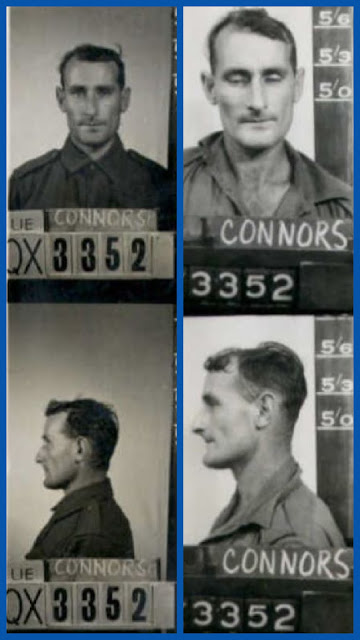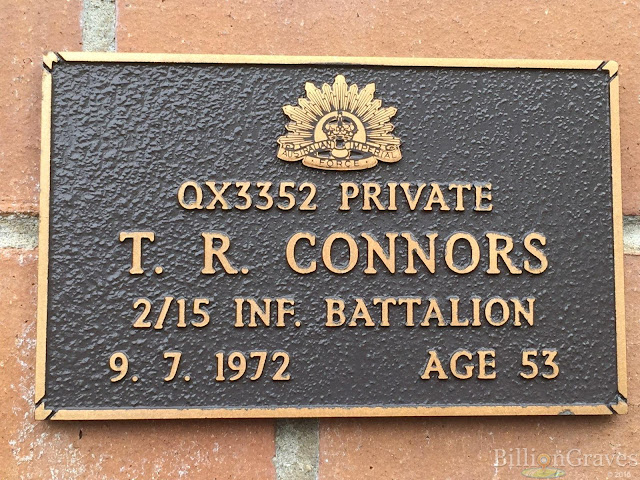Anniversary of a Birthday:
- My paternal uncle, Thomas Richard Connors, was born on the 19th of April 1911, at Mullumbimby, in New South Wales.
- His father was George Thomas Connors and his mother was Grace Olive Brown.
- Thomas was the third-born of eleven children born to George and Grace, and he was known as 'Tommy' to his family.
- Tommy's father George worked on dairy farms in the Richmond Valley / Lismore area of New South Wales between Tommy's birth year 1911 and the early 1920s. The family moved around for quite some time, to wherever George was able to find work. By 1924, when Tommy was 12 years old, the family had moved to Queensland, around the Maleny area at first, but then further south around Beaudesert. By 1936, father George, mother Grace and a few of Tommy's siblings had moved to Gympie.
- In 1932, aged 21, Tommy married Dulcie Elizabeth Charlotte Hunt at Murgon in Queensland, and they went on to have a son two years later. It seems however that the marriage did not last.
- The 1936 and 1937 Australian Electoral Rolls records Tommy living at Mellor Street in Gympie, and there is no mention of his wife Dulcie.
- The 1936 electoral roll record shows he is with his father George and his sister Beryl at Mellor Street. His mother was recorded as living in Wickham Street that day, and I'm not entirely sure why this would be so.

- The 1937 electoral roll record shows Tommy living on his own at Mellor Street, while his parents and older sister have moved to O'Connell Street.
 |
| Image courtesy of the Australian War Memorial AWM ARTV06766. |
- Tommy enlisted with the 2nd AIF on the 3rd of June 1940, exactly nine months after the Australian Prime Minister Robert Gordon Menzies had announced Australia was at war with Germany. He joined the 2/15 Australian Infantry Battalion.
- The attestation form completed and signed by Tommy states that he was 29 years 1 mth old, and that he was single. While he might have been estranged from his wife, he was actually still married at this stage. He gave his address as O'Connell Street in Gympie, which was the address of his parents.
The Siege of Tobruk was a confrontation that lasted 241 days between Axis and Allied forces in North Africa during the Western Desert Campaign of World War Two. The siege started on 10 April 1941, when Tobruk was attacked by an Italo–German force under Lieutenant General Erwin Rommel and continued for 241 days up to 27 November 1941, when it was relieved by the Allied 8th Army during Operation Crusader.
The “Rats of Tobruk” was the name given to the soldiers of the garrison who held the Libyan port of Tobruk against the Afrika Corps during the Siege.
The garrison, commanded by Lieutenant General Leslie Morshead, consisted of the 9th Australian Division (20th, 24th, and 26th Brigades), the 18th Brigade of the 7th Australian Division, four regiments of British artillery and some Indian troops.
(excerpt from www.monumentaustralia.org.au)
 |
| A record of the 'Rats of Tobruk' put together in 2018, p. 102 https://ratsoftobrukassociation.org.au/wp-content/uploads/2021/07/TOBRUK_AK_WEB_020721R.pdf found on the Rats of Tobruk Association website |
- The photo above shows a group portrait of members of the 2/15 Battalion, including my uncle Tommy. He is 3rd from the right. The photo was taken sometime in 1941 when they were serving in the Middle East. Only four men in this group returned home to Australia at the end of the war.
- Tommy also served at El Alamein as a Bren Gunner, for about four to five months, and he would recall later on that "There was a lot of shelling on the first night and we were shelled for about four to five days. The noise of our own artillery guns was very bad and we couldn't sleep." That was his experience in just the first week there.
- After being withdrawn from the Middle East, the 2/15 Battalion then served in New Guinea, from 1943 to 1946. During those years, Tommy suffered many bouts of malaria and both his physical and psychological health deteriorated.
- I know from stories told by my father (who was Tommy's brother), that the war experiences were deeply traumatic for Tommy and left wounds not visible to the eye. A photo of Tommy was taken upon his discharge in January of 1946 and when putting his enlistment and discharge photos side-by-side, I think the impact of his war service is clearly evident.
- At the beginning of 1945, Tommy's first marriage had been dissolved by decree of the Supreme Court of Brisbane.
- He was discharged from the Australian Military Forces in January of 1946.
- After his discharge, Tommy married Catherine Millicent Soames (known as Cathy) when he was 36 years old. They were married in Nambour, Queensland in 1947. At that time, Tommy was working as a public works employee.
- The 1949 electoral roll shows Tommy, aged 38, and wife Catherine living in Channon Street, Gympie.
- Tommy and Catherine went on to have four children, and during the 1950s the family was living at Imbil, near the Imbil State Forest in southern Queensland.
- The 1954, 1958 and 1963 electoral rolls show that Tommy and Catherine were living at Stirling Crossing at Imbil, and Thomas's occupation was forestry worker.
- The 1969 electoral roll shows Tommy, aged 58, was still working as a forestry labourer, but was now living back in Gympie with his wife Catherine.
- Sadly, Tommy passed away not much later, in 1972, aged 61. He was buried at the cemetery in Gympie.
- A plaque was also erected to Tommy's memory at the Garden of Remembrance in Brisbane, in honour of his service to our country.
- Fittingly and rightly so, Tommy's grandson has proudly marched in a previous Anzac Day parade wearing his grandfather's medals.
- On this 2023 Anzac Day, 77 years after Tommy's discharge from war service, we remember him.














No comments:
Post a Comment